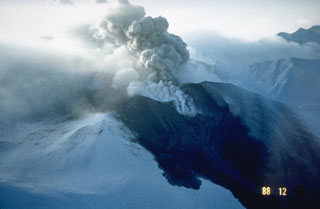Report on Tokachidake (Japan) — November 1988
Scientific Event Alert Network Bulletin, vol. 13, no. 11 (November 1988)
Managing Editor: Lindsay McClelland.
Tokachidake (Japan) Earthquakes and large steam plume
Please cite this report as:
Global Volcanism Program, 1988. Report on Tokachidake (Japan) (McClelland, L., ed.). Scientific Event Alert Network Bulletin, 13:11. Smithsonian Institution. https://doi.org/10.5479/si.GVP.SEAN198811-285050
Tokachidake
Japan
43.418°N, 142.686°E; summit elev. 2077 m
All times are local (unless otherwise noted)
Local seismicity was at a high level in November. A seismometer, 4.5 km NW of the three craters active in 1962, recorded 29 events on 15 November, 9 on the 19th, and 10 on the 26th. The month's total increased to 93 from [43] in October. Four shocks were felt, three on 15 November and one on the 27th. Epicenters were estimated to be around crater 62-2. On 22 November, personnel at the JMA Tokachidake Observatory saw a 1,200-m steam plume emerge from crater 62-2, the highest since a 1,400-m plume in June 1981.
Addendum. The press reported that Tokachi began to erupt on 19 December at 2148 [but see 13:12], ejecting incandescent tephra and a plume that rose about 2 km. Ash fell on two cities more than 100 km NE of the volcano. A lahar about 30 m wide flowed 2.5 km downslope. Children within 25 km of the volcano were kept home from school the next day and residents were warned by officials to be ready to evacuate. The eruption had apparently declined, but seismicity was continuing.
Geological Summary. Tokachidake volcano consists of a group of dominantly andesitic stratovolcanoes and lava domes arranged on a NE-SW line above a plateau of welded Pleistocene tuffs in central Hokkaido. Numerous explosion craters and cinder cones are located on the upper flanks of the small stratovolcanoes, with the youngest Holocene centers located at the NW end of the chain. Frequent historical eruptions, consisting mostly of mild-to-moderate phreatic explosions, have been recorded since the mid-19th century. Two larger eruptions occurred in 1926 and 1962. Partial cone collapse of the western flank during the 1926 eruption produced a disastrous debris avalanche and mudflow.
Information Contacts: JMA; AP; UPI.

